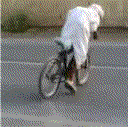Tire Dynamics
Basics
Modern sport tires are sticky enough to stoppie, wheelie, and drag parts while hanging off. That's all the traction you can use, and usually they have some reserve beyond that too. On a dry surface, you have to work to exceed the limits of a modern sport tire.
Touring tires may not have the traction to do all that. They may slide if you put too much force into them without having enough weight on that end. It's even possible that you could exceed the tire compound's ability to hold the track, and the tire itself would start to slide because the rubber just can't grip any harder. This is roughly what happens to any tire that overheats.
So your choice of tire may limit you in how hard you can brake, turn, and accelerate. Just be aware of that, and approach the limits from the safe side.
The Tire Itself
Even touring tires can almost always handle the demands of steady-state forces. What really breaks a tire loose is not the amount of force, but sudden loads -- like suddenly getting on the brakes harder, or the engine suddenly coming into a peaky power band, or countersteering too quickly.
So be aware of not only how hard you're doing things to the tire, but how suddenly. Remember the tire is flexible, and when you steer it takes a moment for those forces to transmit down to the contact patch with the road.
Give the tire a chance to catch up.
Differences -- the rate of building forces
The biggest practical difference -- in terms of technique -- between sport tires and touring tires is the time they need to catch up. You can slam a sport tire around any old way, and it'll keep up pretty well. With a touring tire you need to build the forces progressively, and not overload it with peak transitions. Either way, though, the tire benefits from smoothness, from a smooth progression from one state to another.
Give the tire a chance to catch up.
Sport tires don't need much of a chance. In fact, with modern sport tires on dry pavement you won't break the front end free just by countersteering -- not if you trail-brake properly, anyway. But that does all change if it's raining, or you're running on cold race tires.
Rain
Riding in the rain is a different matter. On a wet track you can exceed the limits of the tires much more easily. Although the principles of riding in the rain are the same as riding in the dry, there are enough other considerations that we'll cover this later.
From TrackDoD Novice Group Orientation
Subscribe to:
Post Comments (Atom)



No comments:
Post a Comment